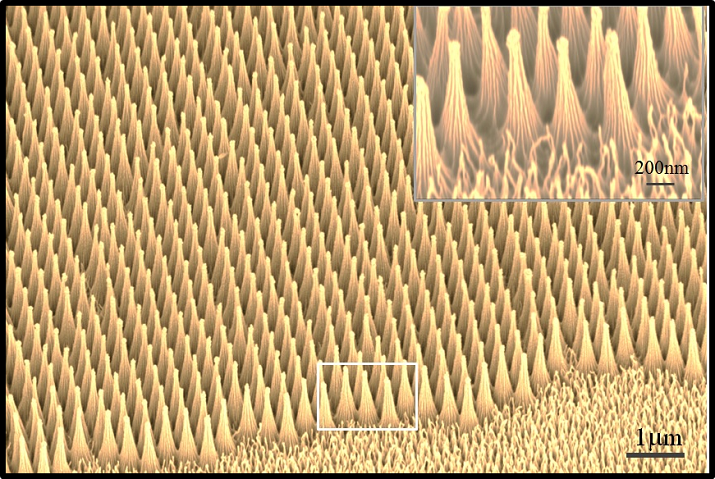The National Nanotechnology Coordination Office (NNCO) is pleased to announce the winner of the first EnvisioNano nanotechnology image contest for students. Kyle Nowlin from the University of North Carolina Greensboro Joint School of Nanoscience and Nanoengineering won the top honors for his image entitled Polymer Nanocone Array. The image, shown below, explores new ways of controlling the spread of bacteria and fungi through the use of nanostructured surfaces (NSS). Many insects have NSS that kill microbes on the outermost layer of their exoskeletons, protecting them from infection. Kyle’s research concentrates on creating new synthetic NSS materials in the lab that resemble those found in nature. Congratulations to Kyle!
Thirty-two images were submitted by 10 students from universities across the country. Images were posted online for public voting. The top five images advanced to the semifinalist round. The final winner was chosen by representatives of the National Nanotechnology Initiative member agencies. The winning image will be displayed on Nano.gov for a month. For more information on the EnvisioNano contest rules and judges, visit the EnvisioNano page on Nano.gov.

Polymer Nanocone Array: The surface is a polymeric nanocone array that is generated by colloidal lithography, i.e. a masking of a polymeric substrate by nanoscale beads followed by a reactive ion etching. The inset shows more detailed structure to the individual nanocones which have 20nm ridges along their length. The image was acquired using a Zeiss Auriga SEM with the InLens detector and a 2keV electron beam.
Image by: Kyle Nowlin
Advisor: Dr. Dennis LaJeunesse
School: University of North Carolina Greensboro, Joint School of Nanoscience and Nanoengineering, Department of Nanoscience
Kyle's description of his research: "Many insects display nanostructured surfaces (NSS) on their cuticles and many of these native NSS are inherently antimicrobial and kill microbes by mechanical/structure means. Our research explores the mechanisms that underlie the rupture of microbes on NSS. The native insect cuticles are complex materials that are difficult to replicate and to control specific surface properties. We have applied a colloidal lithographic process to generate novel synthetic NSS materials that resemble their biological insect cuticle counterparts in scale and shape but by using different polymeric materials to make these NSS can control surface properties of our biomimetic NSS. In this manner we will systematically identify the mechanical and physiochemical properties of rupturing NSS that lead to microbial demise. The goal of this research is to develop novel means of controlling the spread of pathogenic bacteria and fungi through nanostructured materials."
This work was supported by the North Carolina Biotechnology Center (NCBC) Biotechnology Research Grant and through the generous support of Dr. James Ryan, the Joint School of Nanoscience and Nanoengineering, and the State of North Carolina.
###


